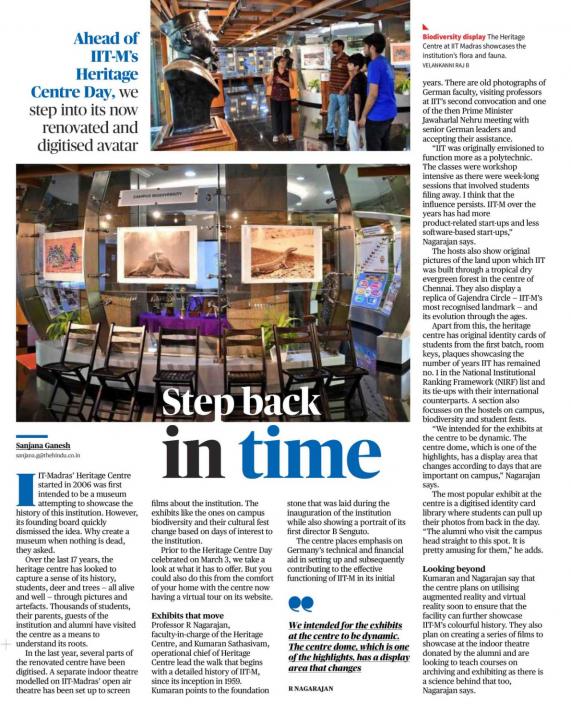
Step back in time at IIT-M’s digitised heritage centre
- 2nd Mar 2023
-
The Hindu
Indian Institute of Technology- Madras' (IIT-M) heritage centre located metres away from towering, thick banyan trees, tells the story of the institution's inception, achievements, campus life and biodiversity. Ahead of its heritage centre day on March 3, we step into its now renovated and digitised avatar
IIT-Madras' Heritage Centre started in 2006 was first intended to be a museum attempting to showcase the history of this institution. However, its founding board quickly dismissed the idea. Why create a museum when nothing is dead, they asked.
Over the last 17 years, the heritage centre has looked to capture a sense of its history, students, deer and trees - all alive and well - through pictures and artefacts. Thousands of students, their parents, guests of the institution and alumni have visited the centre as a means to understand its roots.
In the last year, several parts of the renovated centre have been digitised. A separate indoor theatre modelled on IIT- Madras' open air theatre has been set up to screen films about the institution. The exhibits like the ones on campus biodiversity and their cultural fest change based on days of interest to the institution.
Prior to the Heritage Centre Day celebrated on March 3, we take a look at what it has to offer. But you could also do this from the comfort of your home with the centre now having a virtual tour on its website.
Exhibits that move
Professor R Nagarajan, faculty-in-charge of the Heritage Centre and Kumaran Sathasivam, operational chief of Heritage Centre lead the walk that begins with a detailed history of IIT-M, since its inception in 1959. Kumaran points to the foundation stone that was laid during the inauguration of the institution while also showing a portrait of its first director B Senguto.
The centre places emphasis on Germany's technical and financial aid in setting up and subsequently contributing to the effective functioning of IIT-M in its initial years. There are old photographs of German faculty, visiting professors at IIT's second convocation and one of the then Prime Minister Jawaharlal Nehru meeting with senior German leaders and accepting their assistance.
"IIT was originally envisioned to function more as a polytechnic. The classes were workshop intensive as there were week-long sessions that involved students filing away. I think that the influence persists. IIT-M over the years has had more product-related start-ups and less software-based start-ups," Nagarajan says.
The hosts also show original pictures of the land upon which IIT was built through a tropical dry evergreen forest in the centre of Chennai. They also display a replica of Gajendra Circle - IIT-M's most recognised landmark - and its evolution through the ages.
Apart from this, the heritage centre has original identity cards of students from the first batch, room keys, plaques showcasing the number of years IIT has remained no. 1 in the National Institutional Ranking Framework (NIRF) list and its tie ups with their international counterparts. A section also focusses on the hostels on campus, biodiversity and student fests.
"We intended for the exhibits at the centre to be dynamic. The centre dome, which is one of the highlights, has a display area that changes according to days that are important on campus," Nagarajan says.
The most popular exhibit at the centre is a digitised identity card library where students can pull up their photos from back in the day. "The alumni who visit the campus head straight to this spot. It is pretty amusing for them," he adds.
Looking beyond
Kumaran and Nagarajan say that the centre plans on utilising augmented reality and virtual reality soon to ensure that the facility can further showcase IIT-M's colourful history. They also plan on creating a series of films to showcase at the indoor theatre donated by the alumni and are looking to teach courses on archiving and exhibiting as there is a science behind that too, Nagarajan says.

